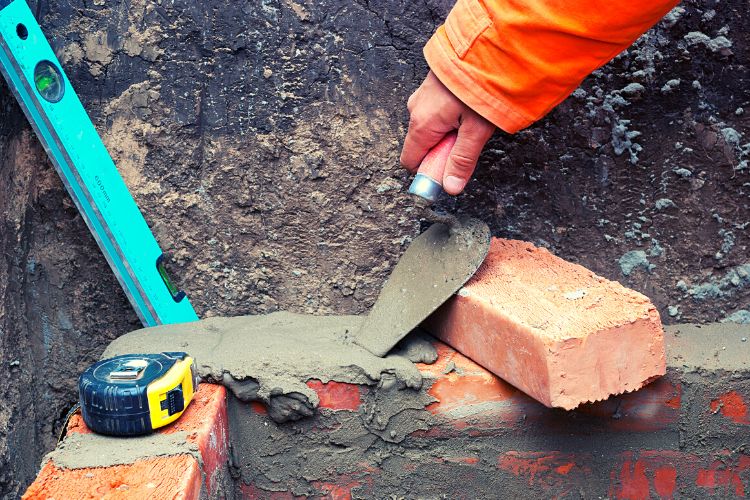When building anything with bricks or blocks, there is a risk of cracking if the correct techniques have not been used. Owing to changes in temperature and moisture, the mortar used to join bricks and blocks will expand and contract.
Using expansion joints ensures that any movement will not result in ugly cracks. While many may think of this as a purely cosmetic issue, the truth is that these cracks could affect the structure of your building so they’re the last thing you want.
Table of Contents
What Is An Expansion Joint?
Brickwork or blockwork expansion joints are usually used where two structures meet. They are used as a form of protection from things like the weather and environmental changes that may otherwise affect the structure of the building due to movement.
When you use an expansion joint, this will separate any masonry into segments which serves as a way of stopping cracks from appearing. These cracks can come from a variety of factors including moisture, temperature changes, settlement and many other things.
You can use both vertical and horizontal expansion joints and when they are placed, there is room for them to partially close whenever the blockwork expands. However, it’s incredibly important to only place an expansion joint at a point that will not affect the structural integrity of the building.
Without the use of expansion joints, a building may still function. However, there is a much higher potential of cracks which could result in expensive repairs.
Not To Be Confused With Other Types Of Building Joints
The expansion joint is just one type of joint used in brickwork and it’s important not to confuse it with other types.
Control joints, for example, are used to determine the location of a crack when working with concrete masonry. These cracks can cause the structure to become weak but a control joint, usually a vertical gap within the material, is filled with elastic substances that allow the joint to open and close as the concrete expands and contracts. When using this type of joint, it is vital to only place them in locations where the structural integrity of the building will not be compromised.
There are also construction joints which are sometimes called cold joints. These are used when there is an interruption to construction. Again, these joints should be placed in locations that will not cause weakness to the rest of the structure.
Types Of Expansion Joints
There are different types of expansion joints and very commonly mastic is used. One of the main reasons that this is such a popular choice is that it is inexpensive and very easy to work with, especially when plugging small joints. The problem is that there are some seriously high ongoing costs to consider.
For example, mastic will usually need to be replaced around every 12 months. If it is not then it will not only affect the aesthetic of the structure but may also allow water to leak in. Even after as little as six month, weather damage could seriously affect the functionality of mastic. Additionally, this material doesn’t tend to hold up well with movement.
For this reason, it is widely recommended to use a foam product for joint filler. These are lightweight and flexible so there’s great resistance to various factors including thermal, chemical and mechanical.
You can purchase these foam strips which can then be located in various points of the building structure and remove tension from it.
There are also synthetic rubber strips which can be compressed and then inserted into the joint. When you use these with a silicone sealant, they’re very effective at keeping out moisture and work particularly well with smaller joints.
How To Correctly Place An Expansion Joint
We have touched on the fact that choosing the right location for your expansion joints is of the utmost importance where structural stability is concerned.
Where vertical movement is concerned, you’ll find that it’s usually the south facing portions of a structure that are most affected. Using foam expansion joints is the best way to handle this.
There should generally be between ten and twelve metre spacings between expansion joints and this will continue over the entire structure. However, it’s also essential that the first joint is positioned no more than six metres from any corner otherwise you won’t be able to achieve correct spacing around corners.
That said, factors such as windows and doors, the type of brick you’re working with and the position of wall ties, among other things will affect where joints can be placed.
When it comes to applying your filler, you need to make sure that you use 30% more filler than the distance between each joint.
Where buildings are more than four storeys, there is a greater risk of horizontal movement. This is why it’s a good idea to also install horizontal joints for taller structures. Anything below 12 metres and it should be OK to build straight up without interruption.
Conclusion
If brickwork or blockwork continues without joints over a large area, then any movement could cause cracking. The result of this could be structural damage which could be very expensive to repair.
Expansion joints are used to counter this problem and while there are several choices in terms of filler material, something like foam is ideal as it’s far more flexible and resistant.
You’ll also need to consider the placement of the joints and while they should generally be 10 to 12 metres apart, there are factors that could affect this.


